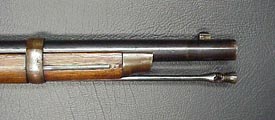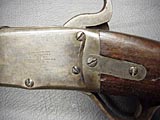
|
|
Russo-Turkish War of Liberation 1877-1878 Chapter Three - Small arms of the warring states - Romania "Peabody" Henry Peabody from Boston constructed the system. It was patented on July 22, 1862. It has an open firing pin and a block bolt falling downwards. The well-known Providence Tool Company produced the gun. Romania received 25,000 American Peabody guns in two deliveries. The first was for the amount of 15,000 received in 1868. Those guns had rim-fire cartridges with caliber of .41 or 10.3 mm. The second delivery was in October 1868 but this time the cartridges were with outer pin fire and caliber of .45 or 11.43 mm. Spare parts and machines for production of cartridge cases at 35,000 pieces a day, were also supplied.1 Initially the Peabody gun was used for arming different units, including the police and fire units in Bucharest. The undoubtedly good qualities were the reason for this. On the eve of the war, the Romanian government decided to arm with Peabody only I and II divisions of the standing army, which had participated in the siege of the town of Pleven. The other two divisions were armed with Dreyze, which was later replaced by Krnka.2 The Peabody gun was the first system with falling block bolt. The firing clutch is elongated and enlarged to act simultaneously as a lever. With the help of the lever, the bolt block moves downwards, putting in the cartridge and the lever is pushed upwards, with which the bolt lifts up. The firing pin is uncovered and is tucked in with a hand. The needle carrier is the weak point of the block bolt. In both modifications it is placed on the right side of the block bolt. Less strength was needed for rim-fire cartridges and the constructive solution was successful. With the new cartridges, however, the constructor had not changed the place of the needle carrier and had just moved it to the front end of the bolt connecting it to the carrier on the right. In this position the carrier bends decreasing the firing strength or simply fails. As regards all other characteristics, the gun came close to the American modification of Martini-Henry and was one of the most up-to-date systems during the war.
|
Mannlicher ©2003-2004. All rights reserved. No part of this site can be reproduced in any way without the explicit permission of the authors.




